

Learning to Learn. Learning to Learn Learning to learn or metacognition, as it’s called, should start with young learners in nursery school so it becomes a habit.
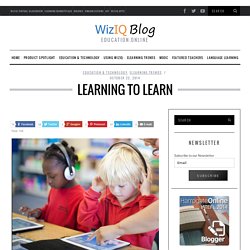
As we get older, we have less time to reflect about the learning process. Developing new habits become difficult. Developing Metacognition. Metacognition is thinking about thinking, knowing "what we know" and "what we don't know.
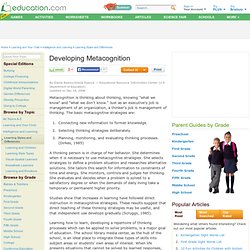
" Just as an executive's job is management of an organization, a thinker's job is management of thinking. The basic metacognitive strategies are: Connecting new information to former knowledge. Selecting thinking strategies deliberately. Planning, monitoring, and evaluating thinking processes. A thinking person is in charge of her behavior. Studies show that increases in learning have followed direct instruction in metacognitive strategies. Teaching Excellence in Adult Literacy (TEAL) Metacognition is one’s ability to use prior knowledge to plan a strategy for approaching a learning task, take necessary steps to problem solve, reflect on and evaluate results, and modify one’s approach as needed.
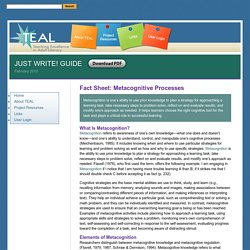
It helps learners choose the right cognitive tool for the task and plays a critical role in successful learning. Expanded Academic ASAP - Document. Full Text: Awareness of what one knows or doesn't know falls under the heading of metacognition, the active process of knowing.
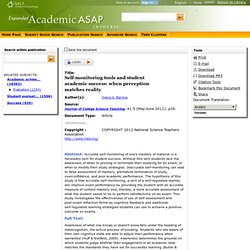
Students who are aware of their own cognitive state are able to adjust their performance when warranted (Huff & Nietfeld, 2009). Awareness determines the grounds on which students judge whether their engagement in an academic task matches the standards they have set for successful learning (Butler & Winne, 1995). Yet the use of cognitive strategies, those that allow one to learn, remember and understand, alone is not enough. Cognitive strategy use coupled with self-regulatory strategies, those that help students monitor, regulate, and control cognition, motivation, and behavior, are the most conducive to successful academic performance (Pintrich & de Groot, 1990).
The role of self-monitoring Feedback that occurs after a task is completed is defined as outcome feedback. Teaching Metacognition: The Value of Thinking About Thinking. July 10, 2012 by Bill Jenkins, Ph.D Research performed in the past few decades has demonstrated that we can improve reading skills by teaching students “metacognitive strategies.” A Metacognitive Peer Tutoring Model: Linking Thinking, Learning and Performance in a Peer Tutoring Program. What can be gleaned from analyzing two years of metacognitive tutoring documentation reports?

Invaluable insights into students’ thinking,Rare windows into how students’ interpret tasks,Clearer understandings of how learners define roles and responsibilities in learning environments,Common themes for how students interact with content across a broad array of academic domains. This article introduces a series of commentaries on metacognitive peer tutoring, each of which will offer useful insights into why students struggle and where they encounter problems in their learning routines. Also provided in each article will be innovative strategies and tactics to improve student learning and performance. You definitely want to follow this blog so you can be notified of each article in the series. About the Data The data behind this series consists of 522 documentation reports collected during the 2012-2014 academic years. That’s me in the pic. Teaching Metacognition. This webpage is a summary, written by Carol Ormand, of Marsha Lovett's presentation at the 2008 Educause Learning Initiative conference.
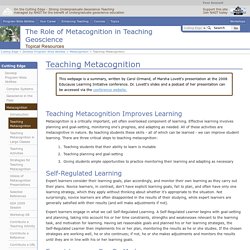
Dr. Lovett's slides and a podcast of her presentation can be accessed via the conference website. Smart Strategies That Help Students Learn How to Learn. Teaching Strategies Bruce Guenter What’s the key to effective learning?
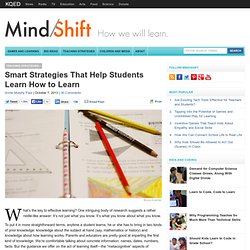
One intriguing body of research suggests a rather riddle-like answer: It’s not just what you know. It’s what you know about what you know. To put it in more straightforward terms, anytime a student learns, he or she has to bring in two kinds of prior knowledge: knowledge about the subject at hand (say, mathematics or history) and knowledge about how learning works. In our schools, “the emphasis is on what students need to learn, whereas little emphasis—if any—is placed on training students how they should go about learning the content and what skills will promote efficient studying to support robust learning,” writes John Dunlosky, professor of psychology at Kent State University in Ohio, in an article just published in American Educator.
Tools for metacognition. Metacognition is an important part of intentional learning, since it involves actively thinking about what you know, what you don’t know, and how you can get better at knowing and applying what you know.
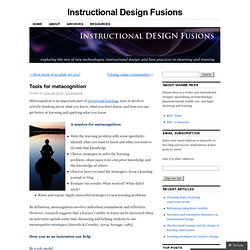
A mantra for metacognition State the learning problem with some specificity: identify what you want to know and what you want to do with that knowledgeChoose strategies to solve the learning problem—draw upon your own prior knowledge and the knowledge of othersObserve how you used the strategies—keep a learning journal or blogEvaluate the results: What worked? What didn’t work? Rinse and repeat: Apply successful strategies to new learning problems By definition, metacognition involves individual commitment and reflection.
How you as an instructor can help Be a role model Think aloud to show your approach to solving problems. Baby steps Help learners appreciate that they’ll grow to be better learners. A “So what? Metacognition and motivation Of course learners still need to be motivated.